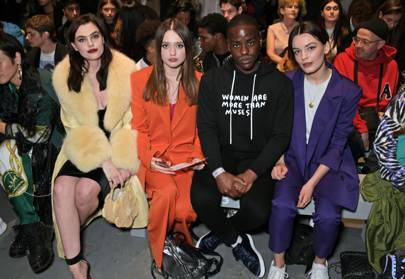Coming up in the screening world ranks is Emma Corrin, who will soon become a household-name owing to her role as Diana, Princess of Wales in season four of Netflix’s royal smash hit, The Crown. The unknown actor has been to Glastonbury with Hunter this summer, sat Centre Court at Wimbledon courtesy of Ralph Lauren, and will undoubtedly crop up at countless parties, launches, junkets and premieres before the series airs in the autumn – all in the name of exposure. We’ve watched it happen before with Stranger Things’s Millie Bobby Brown and Sadie Sink on a global scale.
“Netflix has completely changed the entertainment landscape,” says Kate Stirling SVP and managing director of creative management company, The Wall Group. “Brands now have to be aware of young, promising stars, and expand their network to include digital talent accordingly. At the same time, Hollywood stars are still a major draw.” For stylists, this expanding talent pool can be challenging.
“It seems like everyone is now requesting a stylist,” chimes in Philippe Uter, who dresses Stranger Things actor Noah Schnapp, and a string of high-profile models, including Isabeli Fontana and Lais Ribeiro. “There are too few samples for all of the stars, and there are too many new shows for press outlets to feature.” He tries to “prioritise a TV show that has the power to grow in the media” to build his own portfolio.
Adam Ballheim, who takes charge of Atlanta actor LaKeith Stanfield’s wardrobe, believes the shift in dynamic has given stylists more authority. “There’s much more noise for brands to sort through,” he shares. “We have to make sure our clients are in front of the right designers and are overheard.”

The fresh faces on the scene have opened the door for emerging designers to also have a moment in the spotlight. “It’s all about being strategic and mindful of which clients and events are the right fit for which brands,” continues Ballheim. “Certainly, it’s an issue when 30 stars and their stylists are fighting for look 12 of the same runway show, but I’ve found that once you find that synergy between the talent and a brand, it’s always possible to work out great options.”
When Law Roach first started dressing Disney channel graduate Zendaya, no big brands would lend him looks. So, he got inventive and built his client a reputation for her directional, daring fashion sense – partly by championing young designers, but also by pulling from rails of outfits celebrities had worn before to get her on “Who Wore It Best?” lists. Major houses gradually took note. By the time she scored the lead in TV series Euphoria, the 22-year-old already had a major design collaboration with Tommy Hilfiger under her belt and had been crowned Lancôme’s youngest ever beauty ambassador. Brands weren’t just taking note, they were lining up around the block to dress her. Roach, meanwhile, had branded himself as an “image architect” and won new high profile clients, including Céline Dion.
Similarly, dressing House of Cards’s leading lady, Robin Wright, opened doors for her stylist, Kemal Harris. “A streaming-only concept sounded risky,” Harris initially thought when Wright scored the gig, but as the show garnered traction – and views – Wright brought Harris in to style her character, Claire Underwood. “I had never designed for TV before, so I was quite nervous to accept the position,” Harris continues. “Coming from the red-carpet world in New York City, I was able to call on my fashion industry contacts to really elevate the wardrobe.”
Just as Netflix has achieved legitimacy in the eyes of the entertainment industry (Roma, Alfonso Cuarón’s Netlix-aired love letter to Mexico City, won two Golden Globes, four BAFTAs and three Oscars, despite losing out on the Best Picture statuette, in 2019), it has earnt its value in fashion. “Working with a TV star is not as difficult as it used to be,” says Uter. In fact, by changing the way people consume media and bringing it to the masses, Netflix has become a passport to exposure for everyone involved.

No comments:
Post a Comment